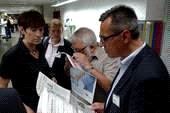Newspaper & Mailroom
WIFAG-Polytype Technologies AG offers a broad basis for new developments in newspaper printing

Thursday 21. August 2014 - At the //wifag users Meeting (June 26-27,2014), there was a clear focus on looking forward: Representatives of newspaper printers from Germany, Slovakia and Switzerland learned about the range of technical opportunities for newspaper production that are arising from //wifag's reorganization.
The host of this year’s meeting was Ringier Print Adligenswil AG, near Lucerne, one of the largest newspaper printing facilities in Switzerland. In addition to daily newspapers (Blick, Neue Luzerner Zeitung), customer newsletters for Migros and Coop and a number of trade, party, church and special interest newspapers are produced here. Ringier Print Adligenswil last modernized its machinery with WIFAG Evolution 371 rotations in 2009.
Where is the future of newspaper printing? – That was the central question of the two-day event, which included a mix of presentations and company tours as well as ample time to network, including during a boat cruise on Lake Lucerne.
However, attendees were mainly interested in the increasing technological breadth of WIFAG-Polytype Technologies AG, where digital printing, coating and laminating was recently merged with the rotation machines area. Thanks to its proprietary expertise in the areas of software, print head control, web threading and drying as well as inks and materials, WIFAG-Polytype Technologies AG can now offer a complete range of both traditional and digital production solutions. And such solutions should, emphasized CEO Jörgen Karlsson, be devised in collaboration with customers.
On the first day of the event, participants at the user meeting following the welcome by Kurt Hegele (CEO of Ringier Print) and Hugo Haymoz (Head of Customer Services //wifag) were able to learn more about Ringier Print Adligenswil .
Bernd Zipper (CEO of Zipcon Consulting) then looked ahead to the year 2030 in his presentation. How will newspapers change? Will people even read newspapers in the future? The increasing online presence of media already makes reading newspapers seem old fashioned. “However, there will always be a justification for newspapers, especially thanks to the flexible printing options of inkjet printing,” said Zipper. One observation is that the trend toward personalization and individualization continues to move forward – i.e., customers can put together their own newspapers and tailor them to their personal preferences. More business news or a more detailed look at sports are just some of the many possibilities. Visually-impaired people can set their newspaper to large-print mode, rendering the cumbersome task of using a magnifying glass unnecessary. Zipper urged people to change their thinking and added: “Take advantage of the new digital printing technology and come up with new ideas for making newspapers more attractive.”
Hugo Haymoz opened the second day of the meeting with information about the new organization of the service area. All of the service areas of the former WIFAG Maschinenfabrik AG, Polytype Converting AG and the Digital Printing business area of Polytype AG have been merged into WIFAG-Polytype Technologies AG. The aim of this merger is to promote the transfer of knowledge of the respective technologies (offset, digital, converting) in order to be able to utilize a broader resource basis. As Haymoz emphasized, “All contacts, services and products will remain the same. Service agreements and contracts will also be taken over and continued unchanged.”
Next, Pascal Clemencon (Technical Sales) introduced the results of the “gloss coating for newspapers” trial series. In these trials, the coating was rolled over an anilox roller onto the printed newsprint in the conventional manner.
However, because of the raw structure of the paper the coating flows into the “valleys” and from an angle of approx. 60 degrees the coating effects disappears completely behind the “hills”. As a result, this process is not suited for producing high-quality gloss. At most, it helps with the abrasion protection of the printing ink.
Carsten Salomo (Digital Competence Center project manager) then showed an alternative option for coating using digital printing technology. Even spot coating is now possible with inkjet printing. //wifag already provides the corresponding print modules with print head control and color provision for Steinemann AG. “Thus, a module can also be integrated seamlessly into newspaper rotation machines,” said Salomo, who also provided an overview of the current state of technology with regard to inkjet printing. In particular, the personalization of newspapers, as Bernd Zipper discussed, will require more flexible printing processes. For example, the same newspaper run can include text that remains the same (offset printing) and personalized content, such as horoscopes, specific articles, addresses, etc. (digital printing).
Rolf Mani (Head of Automation) then discussed the numerous retrofit projects for newspaper printing machines that have been underway over the past several months. For example, new drive retrofits have been installed for roll changers, draw rollers and satellites around the world.
In addition, color register controls, cutting position controls, expanders, etc. have been integrated into the existing equipment. With the “Alpina” control panel and the development of a proprietary color thickness regulator, further important steps toward the automation of newspaper printing have been taken.
In conclusion, Jörgen Karlsson discussed the new WIFAG-Polytype Technologies AG. “We are merging our expertise in newspaper and book printing with the coating, finishing and drying technology,” said Karlsson. He added: “We can now meet customer needs more flexibly and quicker. We now have the ability to provide individual print modules through to the complete equipment with developed print and finishing processes from a single source.” Jörgen Karlsson underscored the stability of WIFAG-Polytype Technologies AG to the company’s newspaper printing partners. He continued: “Even if newspaper printing goes digital in the future, we have the right technology for you.”
User Meeting 2015 take place in Fribourg in order to be able to demonstrate the digital printing technologies of the technology center located there.
